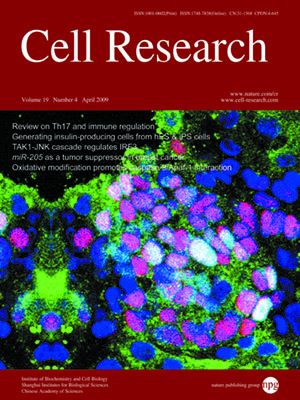
Volume 19, No 4, Apr 2009
ISSN: 1001-0602
EISSN: 1748-7838 2018
impact factor 17.848*
(Clarivate Analytics, 2019)
Volume 19 Issue 4, April 2009: 412-428
ORIGINAL ARTICLES
The TAK1-JNK cascade is required for IRF3 function in the innate immune response
Bianhong Zhang*, Meng Li*, Liang Chen, Kai Yang, Yufei Shan, Lianhui Zhu, Shaogang Sun, Lin Li and Chen Wang
Laboratory of Molecular Cell Biology, Institute of Biochemistry and Cell Biology, Shanghai Institutes for Biological Sciences, Chinese Academy of Sciences, 320 Yue Yang Road, Shanghai 200031, China
Correspondence: Chen Wang, Lin Li,(cwang01@sibs.ac.cn; lli@sibs.ac.cn)
Interferon regulatory factor (IRF)3 is critical for the transcriptional induction of chemokines and cytokines during viral or bacterial invasion. The kinases Tank binding kinase (TBK)1 and Ikappa B kinase (IKK)ε can phosphorylate the C-terminal part of IRF3 and play important roles in IRF3 activation. In this study, we show that another kinase, c-Jun-NH
2-terminal kinase (JNK), phosphorylates IRF3 on its N-terminal serine 173 residue, and TAK1 can stimulate IRF3 phosphorylation via JNK. JNK specific inhibitor SP600125 inhibits the N-terminal phosphorylation without affecting the C-terminal phosphorylation. In addition, IRF3-mediated gene expressions on lipopolysaccharide (LPS) or polyinosinic-cytidylic acid (polyI:C) treatment are severely impaired by SP600125, as well as for reporter gene assay of IRF3 activation. Knockdown of TAK1 further confirmed these observations. Interestingly, constitutive active IRF3(5D) can be inhibited by SP600125; JNK1 can synergize the action of IRF3(5D), but not the S173A-IRF3(5D) mutant. More importantly, polyI:C failed to induce the phosphorylation of mutant S173A and SP600125 dramatically abrogated IRF3 phosphorylation and dimerization that was stimulated by polyI:C. Thus, this study demonstrates that the TAK1-JNK cascade is required for IRF3 function, in addition to TBK1/IKKε, uncovering a new mechanism for mitogen-activated protein (MAP) kinase to regulate the innate immunity.
Cell Research (2009) 19:412-428. doi: 10.1038/cr.2009.8; published online 20 January 2009
FULL TEXT | PDF
Browse 2089


